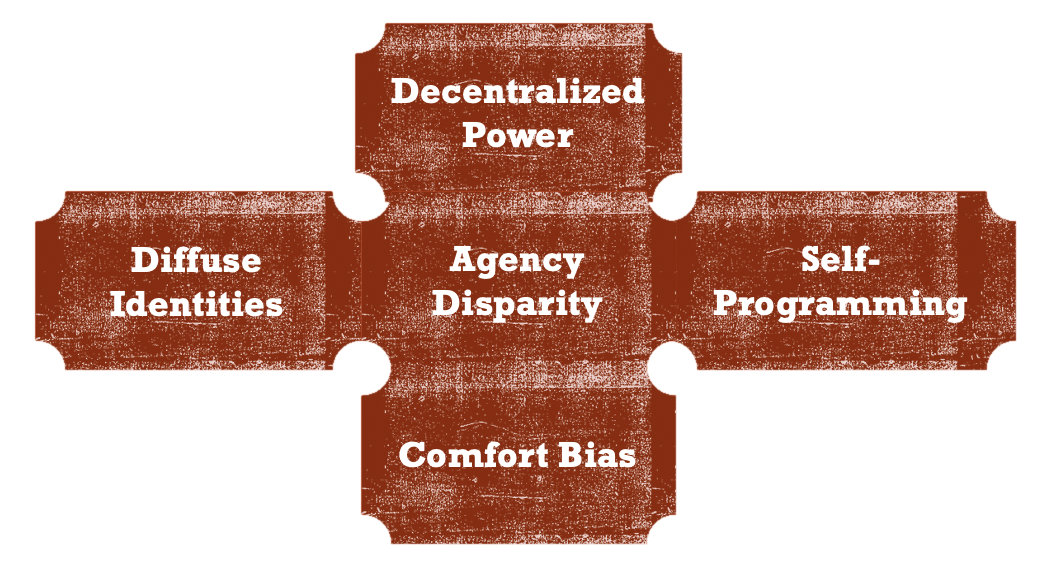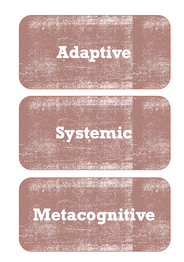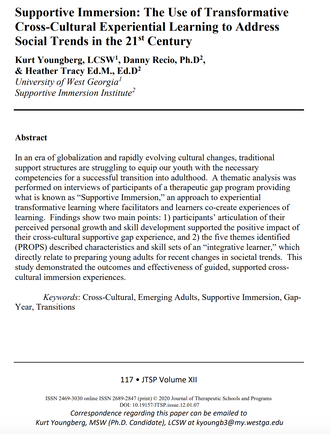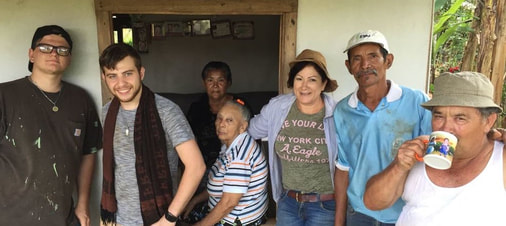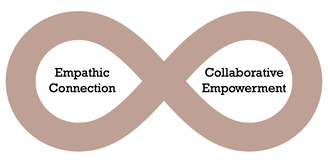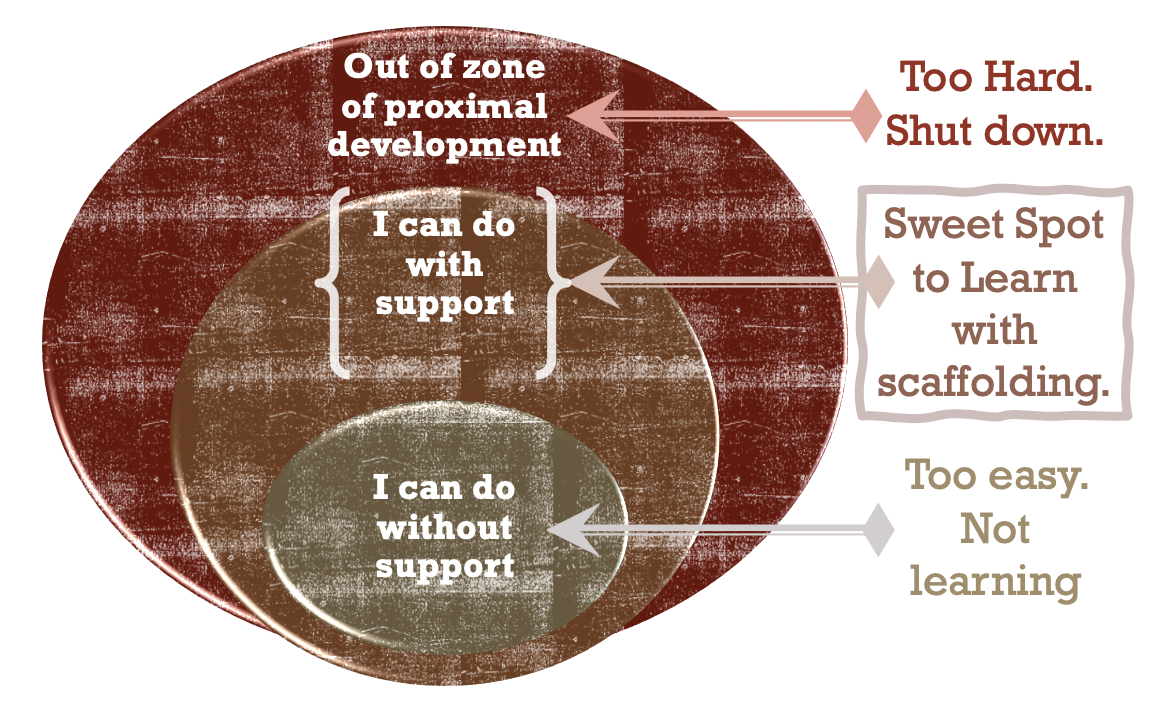|
|
WHAT IS SUPPORTIVE IMMERSION® ? |
|
Supportive Immersion® is an effective approach to facilitate integrative learning.
Why is SUPPORTIVE IMMERSION important?
With the internet and technology now an integrated part of our lives, traditional educational paradigms are no longer sufficient to prepare our highly-connected youth for their futures in the Age of Complexity. Definitions of "success" determine what we measure and how we evaluate youth development, and both need to be updated based on emerging trends for youth. Concepts of success need to shift from providing youth with tools and helping them use tools... to helping them become adaptable tool-makers themselves.
The Information Age has brought about several important trends that directly affect youth development and preparation for "complexity" in today's world:
Supportive Immersion is an educational paradigm that embraces these trends and develops the important skills, strategies and characteristics (PROPS) of an energizing and activating propelling function which leads to Integrative Learning. Watch our recent presentation about these topics and read more below...
©2017 Dr. Danny Recio, PhD & Dr. Heather Tracy, EdD
The Goal - Why?
Our definition of the "goal" or "success": INTEGRATIVE LEARNING (Life-Long Learning)
Integrative Learning is an ongoing process of true life-long learning that values the ever-evolving complexity of our world, how we engage with it, and how we learn to keep learning and growing no matter in what context we find ourselves.
Integrative Learning can be accessed, analyzed, or developed at multiple levels of a system, including the development of a person's internal world, a relationship, a family, a community, an organization, and the world.
Integrative Learning is an ongoing process of true life-long learning that values the ever-evolving complexity of our world, how we engage with it, and how we learn to keep learning and growing no matter in what context we find ourselves.
Integrative Learning can be accessed, analyzed, or developed at multiple levels of a system, including the development of a person's internal world, a relationship, a family, a community, an organization, and the world.
The process of integrative learning is:
|
**Why use the term "Integrative"? Because it is incorporative and internalized in that learning is not something that you do; it becomes who you are.
Integrative learning happens when a particular set of skills or characteristics are activated in conjunction, which all together are called the Propelling Function©. It is not "independence" which denies the obvious state of "interdependence" which a given element of our interconnected lives which are not lived in isolation. Rather the Propelling Function - the ability to activate and generate problem-solving from within - is a key characteristic of a healthy and fully developed person or "self"(1) that propels one towards continuous learning and growth.
Integrative learning happens when a particular set of skills or characteristics are activated in conjunction, which all together are called the Propelling Function©. It is not "independence" which denies the obvious state of "interdependence" which a given element of our interconnected lives which are not lived in isolation. Rather the Propelling Function - the ability to activate and generate problem-solving from within - is a key characteristic of a healthy and fully developed person or "self"(1) that propels one towards continuous learning and growth.
|
Here are the indicators of an activated propelling function (PROPS ©):
©2017 Dr. Danny Recio, PhD & Dr. Heather Tracy, EdD
|
Read more about the 5 trends and PROPS research in this article we published in the Journal of Therapeutic Schools and Programs in 2019.
|
What: The Experience
|
We walk along side adolescents, young adults, parents, families, and communities - helping them immerse themselves outside of their comfort zones so they can grow.
Supportive Immersion® programs and facilitators create and offer structured immersion experiences that connect, empower and facilitate integrative growth through the development of PROPS skills. |
How: The Method
Supportive Immersion® is a person-centered, process-based approach to transformative experiential learning where the use and development of empathic connecting skills, collaborative empowerment, and process-based scaffolded activities invite non-threatening exposure to integrative growth opportunities, leading to the increase of agency (self-governance) as well as shifts in participants' ways of being in the world.
- Empathy is the imaginative entering of another person’s experience, or in other words, putting oneself in other people’s shoes. In SUIM, an emic view is required to experience true empathy. Emic is a word used in anthropology used to describe truths that are individual and culture specific, versus etic, which refers to universal truths. In SUIM, truth is understood as contextual, based on the time, place and angle with which it’s considered. This is an essential element in SUIM, as the facilitator ought to see the learning task from the perspective of the learner, and make an effort to have the learner see it from his. This allows them to synchronize and “meet in the middle”, where they can progress forward in the process using a creative amalgam of both perspectives. Facilitator and learner are encouraged to flexibly address the task at hand, in order to be informed by as many angles and options as possible, with the intention of arriving at original solutions to the task.
- Empathic connection addresses both the "how" and the "why" of a situation or process. The "how" of empathically connecting with someone is a delicate and intentional process that allows empowerment to take place. Being able to empathize sparks the "why" of a situation or process - the emotional and existential aspects of a neural network: What gives this process or experience meaning and purpose? Why does it matter? Tapping into this emotional center creates engagement and connection to the tasks at hand.
- In SuIm, empowerment is reciprocal and collaborative. All participants in the learning process have something to offer and something to learn. There is an intentional focus on identifying the strengths and learning opportunities of all participants, facilitator(s) included. SuIm challenges the notion of aid, which in a hierarchical paradigm, may disempower those receiving the help, creating dependence on the helper and a perception of being less capable than they actually are. Instead, the learner in SuIm owns the learning experience. He is trusted in being able to develop the capabilities from within, as opposed to being a passive recipient of knowledge or information from without. The learner is active and seeks to develop a responsibility to his own learning process. Responsibility here is conceptualized as response-ability, or ability to respond to the learning task.
- Collaborative Empowerment addresses the other part of the "how" of an effective and ethical interpersonal process. Agency is a psychological term that evokes the idea of governance of and ownership of one's own power and one's ability to use one's gifts to give to and receive from one's life and community. Rather than being a passive observer or recipient, collaborative empowerment both increases an individual's agency as well as deepens the understanding that together as one, we learn more and achieve more than we would alone.
- Immersion is experiential. In its growth and development, the brain is most significantly influenced by experiences and the meaning we interpret from these experiences. However, many traditional learning environments and people’s daily lives nowadays can lack opportunities for enriching experiences; thus the opportunities for growth and learning are reduced. SUIM embodies the constructivist view that in order for substantial learning to take place, the person has to live what is being learned. He must immerse himself in the experience to be an active agent and to own his own growth process. The facilitator is also immersed in the learning experience; he or she is not shouting directions from the sidelines, but is instead swimming, walking, living, engaging, and working through the task. Being immersed does not mean the facilitator is doing the task for the learner; it means the facilitator is doing the task with the learner, with the goal of guiding the experience to become a transformative one.
- SUIM guidance is process-based. When engaged in SuIm, reaching a destination is important, but it’s more important to be aware of where we find ourselves in the learning process and to learn effective, appropriate, and meaningful ways of how one gets there and how one grows and learns along the way. SUIM adheres to the old adage: “give a man a fish and you will feed him for day; teach a man to fish and you feed him for a lifetime”. True learning requires integration of what one is experiencing; in order to integrate, one must intentionally engage in a meaning-making and reflective process at various milestones along the way as well as celebrate those moments of successful learning and integration. Furthermore, a process means that it's never stagnant and keeps on going and growing.
|
- Process-Based Scaffolding addresses the "what" of SuIm: This process of scaffolding requires skilled facilitators that can mentor participants in a structured experience that meets them where they are and challenges and supports them to keep growing and learning.
©2016 Dr. Danny Recio, PhD & Dr. Heather Tracy, EdD
Notes:
1. In psychology, the "self" can be called personhood, personality, adulthood, etc. depending on the theory or author.
2. Lev Vygotsky's Zone of Proximal Development
1. In psychology, the "self" can be called personhood, personality, adulthood, etc. depending on the theory or author.
2. Lev Vygotsky's Zone of Proximal Development

